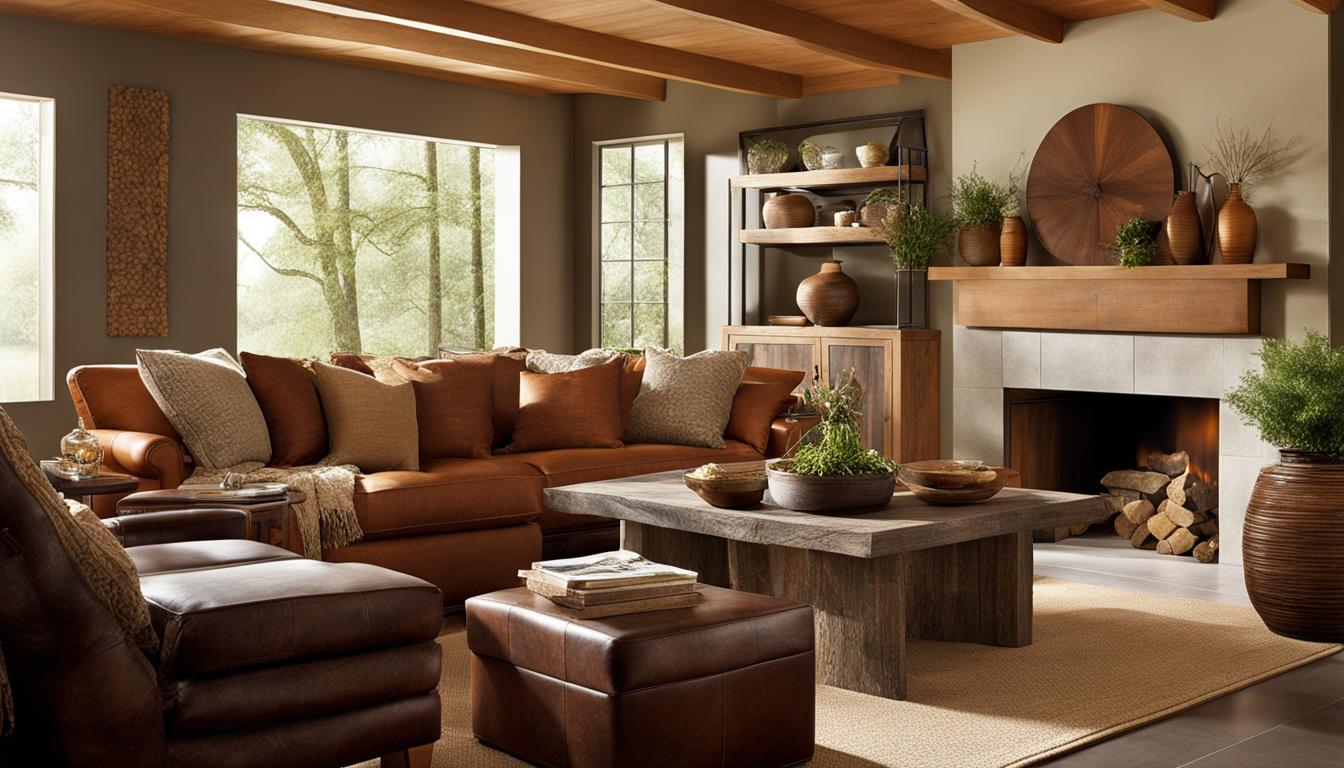Welcome to our guide on Prairie style decor! If you’re looking to infuse your home with a sense of simplicity, harmony, and understated elegance, then Prairie style is the perfect choice. Inspired by the work of architects like Frank Lloyd Wright, Prairie style decor combines the ideals of the Arts and Crafts movement with modern elements. It celebrates the natural landscape, embraces horizontal lines, and incorporates elements of nature throughout the design.
At its core, Prairie style decor embraces the essence of the American prairie, capturing its beauty and tranquility in every detail. With a warm, earthy color palette, open floor plans, and an indoor-outdoor connection, Prairie style creates a calm and inviting atmosphere in your home. Whether you’re drawn to the clean lines, the use of natural materials, or the exploration of motifs, Prairie style offers a timeless and uniquely American design choice.
In this guide, we’ll delve into the origins and characteristics of Prairie style decor, provide tips on incorporating it into your home, explore its application in different rooms, and discover the legacy of Frank Lloyd Wright and the Prairie School. So let’s embark on this journey of simplicity and discover how Prairie style decor can transform your living space into a harmonious sanctuary.
Origins of Prairie Style Decor
Prairie style decor, also known as Prairie School architecture, originated in the early 20th century in Chicago. This uniquely American style was developed by visionary architects like Frank Lloyd Wright and his contemporaries, who sought to combine elements of the Arts and Crafts movement with modern design principles.
Frank Lloyd Wright, an influential figure in the world of architecture, played a pivotal role in shaping the Prairie style. He believed that buildings should blend harmoniously with their surroundings, reflecting the beauty of the natural landscape. Inspired by Louis Sullivan’s architectural theories, which emphasized a distinctly American architecture rooted in nature, Wright and his peers envisioned a new approach to design, one that would capture the spirit of the Midwest.
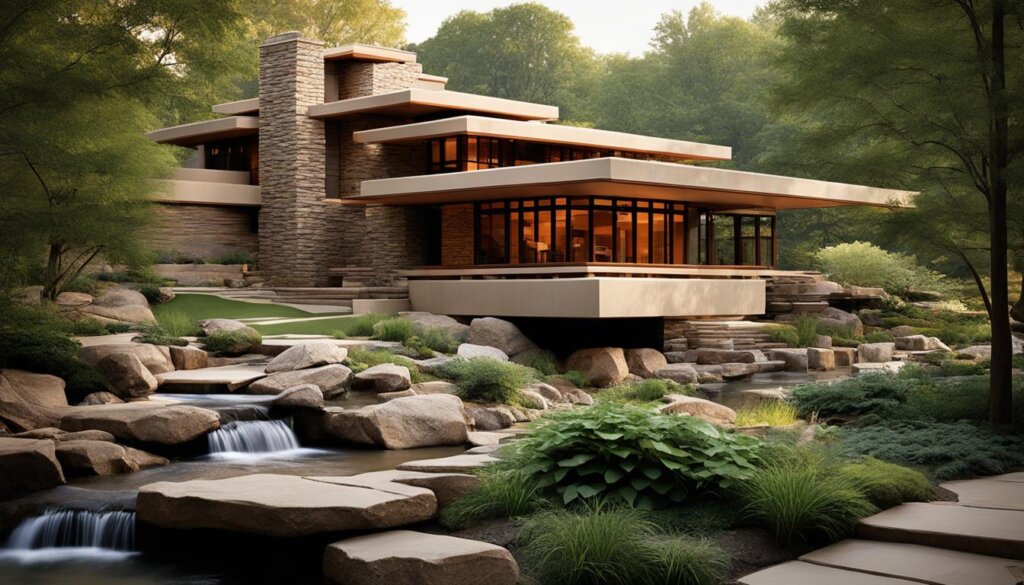
The Arts and Crafts movement, with its focus on craftsmanship, simplicity, and the integration of nature, also left its mark on Prairie style decor. This movement, which originated in Europe and reached its peak in the late 19th and early 20th centuries, celebrated the beauty of handmade objects, natural materials, and traditional craftsmanship. Prairie style decor adopted these ideals, incorporating them into its design philosophy.
Chicago, particularly the suburb of Oak Park, became a hotbed for Prairie style architecture, boasting a concentration of innovative buildings that exemplified this design approach. The style gained popularity not only among architects but also among homeowners who sought to embrace its principles and incorporate them into their own living spaces.
Today, the legacy of Prairie style decor lives on, influencing modern architecture and inspiring homeowners to embrace its timeless elegance, natural materials, and harmonious design.
Characteristics of Prairie Style Decor
Prairie style decor is defined by a unique set of characteristics that captures the essence of the Midwest landscape. The design emphasizes horizontal lines, mirroring the expansive and low-lying nature of the region. Buildings are carefully arranged on their lots, allowing them to seamlessly integrate with the surrounding environment.
To achieve the distinct Prairie style look, structures often feature flat or shallow hipped roofs, rows of windows that invite an abundance of natural light, and overhanging eaves. The exteriors are typically adorned with bands of stone, wood, or brick, creating a harmonious blend with the natural surroundings.
In contrast to traditional architectural styles, Prairie buildings embrace open floor plans that promote functionality and visual flow. These layouts often have asymmetrical designs and prioritize the connection between indoor and outdoor spaces. This seamless integration allows residents to enjoy the breathtaking beauty of nature from the comfort of their homes.
The restrained ornamentation is another hallmark of Prairie style decor. Rather than overwhelming with excessive detailing, the focus is placed on exploring motifs. A single shape or plant form is elegantly incorporated throughout the design, creating a sense of unity and continuity.
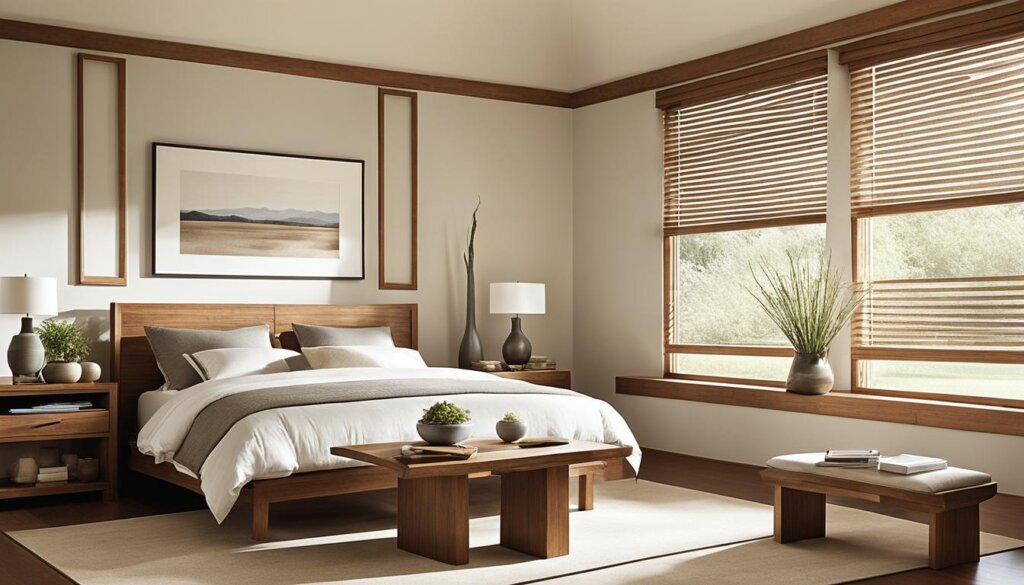
Through the use of these defining characteristics, Prairie style decor showcases the simplicity and elegance that have made it a timeless choice for homeowners who seek to embrace nature’s beauty in their everyday lives.
Incorporating Prairie Style Decor in Your Home
When it comes to bringing the timeless beauty of Prairie style decor into your home, there are a few key elements to consider. By incorporating these Prairie style decorating tips, you can create a warm and inviting space that reflects the natural charm of the prairie.
1. Embrace Horizontal Lines and a Long, Low Aesthetic
Prairie style decor celebrates the horizontal landscape of the Midwest. Emphasize horizontal lines in your design, from furniture placement to architectural elements. Choose low-profile furniture that extends horizontally to create a sense of openness and harmony.
2. Emphasize Natural Materials
Natural materials such as wood, stone, and brick play a vital role in Prairie style decor. Incorporate these materials into your furniture, flooring, and accents. Opt for solid wood pieces with clean lines and minimalistic designs. By embracing natural elements, you can capture the essence of the prairie in your home.
3. Flowing, Open Floor Plans
Prairie style decor encourages a seamless flow between indoor and outdoor spaces. Create an open floor plan that allows for easy movement and connectivity. Use furniture placement and architectural elements to guide the flow and create a sense of unity throughout your home.
4. Utilize Restrained Ornamentation
Avoid excessive ornamentation and instead focus on subtle and restrained decorative elements. Prairie style decor values simplicity and clean lines. Incorporate minimalist decorative pieces that complement the natural materials used in your design.
5. Incorporate Motifs and Plant Forms
One of the defining characteristics of Prairie style decor is the exploration of motifs and plant forms. Incorporate these elements throughout your design, whether it’s through wallpaper patterns, artwork, or even in the shape of furniture. This creates a cohesive and harmonious aesthetic that is synonymous with Prairie style.
6. Warm, Earthy Color Palette
To fully capture the essence of Prairie style, embrace a warm and earthy color palette. Opt for shades inspired by nature, such as warm browns, golden yellows, deep greens, and soft neutrals. These colors evoke a sense of coziness and tranquility, creating a welcoming atmosphere in your home.
By following these Prairie style decorating tips, you can incorporate the key elements of this timeless design style within your own home. Embrace the simplicity, harmony, and understated elegance of Prairie style to create a space that truly reflects your personal style and celebrates the beauty of the prairie.
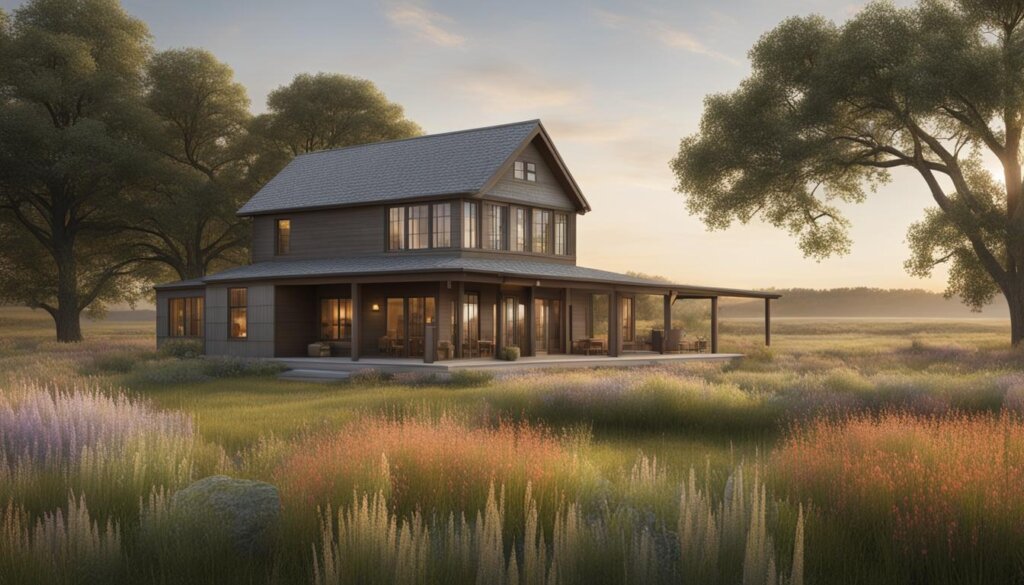
Prairie Style Decor in Different Rooms
Prairie style decor can be applied to various rooms in your home, allowing you to create a cohesive and harmonious design throughout. Let’s explore how you can embrace Prairie style in different areas of your home:
Prairie Style Kitchen
Incorporate Prairie style elements into your kitchen design by focusing on simple shapes and light natural woods. Choose cabinets with clean lines and opt for contemporary accents like stainless steel appliances. This combination of natural materials and modern touches will create a timeless yet functional Prairie style kitchen.
Prairie Style Family Room
When designing your family room in Prairie style, prioritize natural materials like stone and hardwood. Select furniture with clean lines and earthy fabrics to create a cozy and inviting space. Consider adding a fireplace as a focal point and incorporating nature-inspired accessories to enhance the Prairie style aesthetic.
Prairie Style Master Bathroom
Create a calming oasis in your master bathroom with Prairie style decor. Choose neutral colors to create a serene atmosphere and incorporate natural elements like hardwood floors and stone accents. Enhance the ambiance with soft, soothing lighting and add Prairie style touches like geometric patterns in tiles or wallpaper.
Prairie Style Three-Season Porch
Transform your porch into a Prairie style retreat by embracing natural materials and earthy colors. Use durable yet comfortable seating and arrange it in a way that encourages relaxation and conversation. Consider adding an outdoor fireplace or a built-in grill to create a cozy and inviting three-season porch.
Prairie Style Outdoor Living
Extend your Prairie style decor to your outdoor living area by incorporating outdoor furniture made from natural materials like wood or rattan. Choose earthy colors like brown, green, and beige to complement the surrounding landscape. Add comfortable cushions and throws for a cozy touch and create a relaxing space where you can enjoy nature.
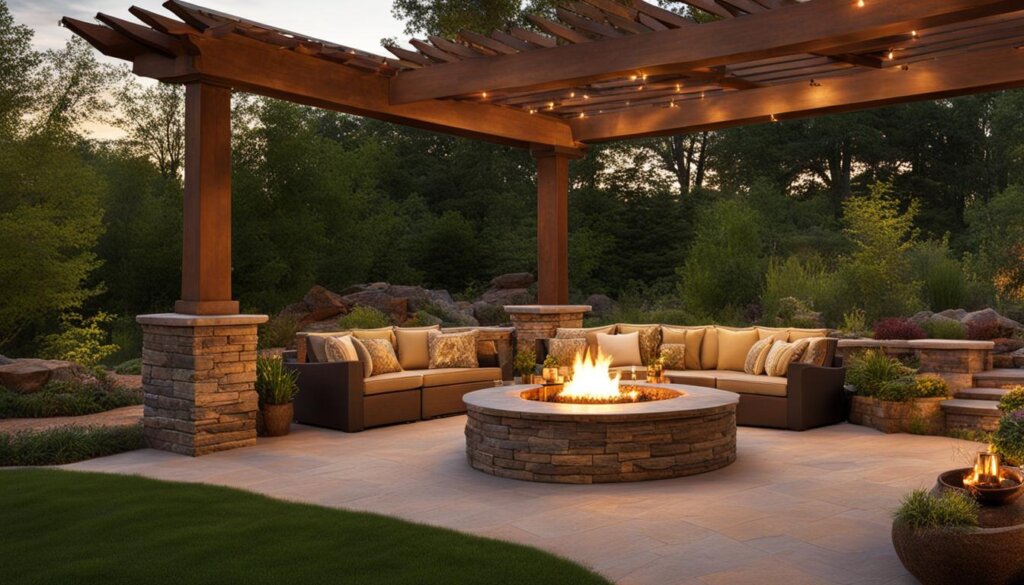
Frank Lloyd Wright and the Prairie Style Legacy
Frank Lloyd Wright played a pivotal role in the development of Prairie style decor. As an architect, his practice in Oak Park, Chicago, served as the birthplace of this uniquely American style. Wright’s philosophy of Organic Architecture, which emphasizes designing buildings in harmony with their environment, greatly influenced the entire Prairie School of architecture.
The Prairie School movement aimed to create architecture that reflected the expansive prairie landscape and celebrated the simplicity and beauty of the Midwest. This architectural style, with its emphasis on horizontal lines, open floor plans, and connected indoor-outdoor spaces, was a departure from the verticality of traditional architectural designs.
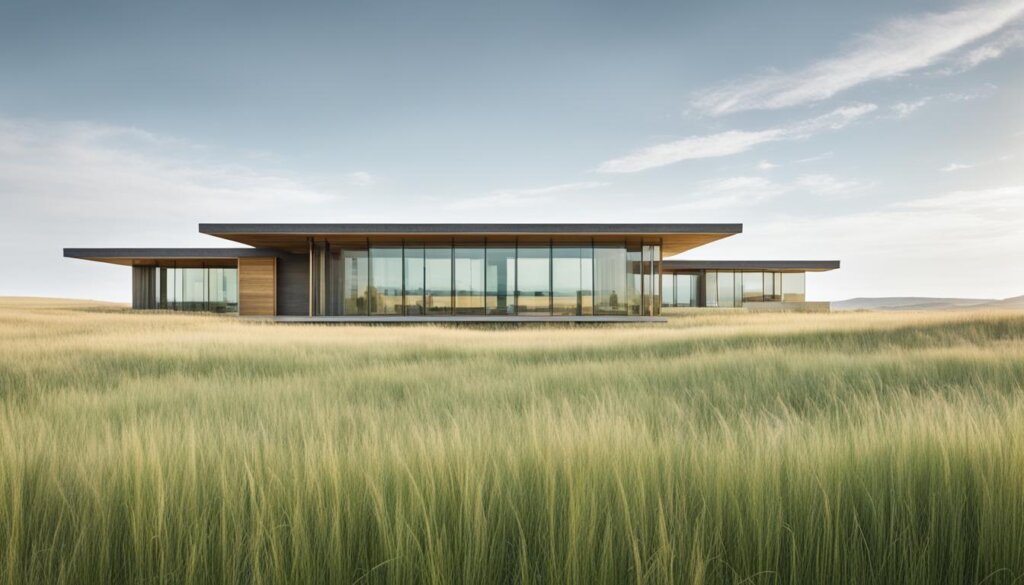
Although the popularity of Prairie style decor waned after 1915, its influence can still be observed in modernist architecture and mid-century ranches. The principles championed by Frank Lloyd Wright and the Prairie School continue to inspire architects and designers today, emphasizing the integration of nature, functionality, and aesthetics in architectural and interior design.
Embracing the Essence of Prairie Style Decor
Prairie style decor is a celebration of simplicity, harmony, and understated elegance. It is an expression of the natural landscape, with its use of horizontal lines and incorporation of elements inspired by nature. By embracing Prairie style decor, you can bring a sense of calm and serenity to your home, creating a space that is both inviting and timeless.
When incorporating Prairie style decor, it is important to emphasize natural materials such as wood and stone. Opt for open floor plans that allow for easy flow between indoor and outdoor spaces, blurring the boundaries between the two. This connection to nature is a key characteristic of Prairie style decor.
Choose furniture and accessories that reflect the beauty of the prairie. Look for pieces that feature clean lines, earthy colors, and organic shapes. The use of warm color palettes, inspired by the natural hues of the prairie, will create a warm and inviting atmosphere in your home.
Prairie style decor is a uniquely American design choice that embraces simplicity and elegance. By incorporating its principles into your home, you can create a space that embodies the essence of the prairie and brings a touch of tranquility to your everyday life.
Source Links
- https://www.architecture.org/learn/resources/architecture-dictionary/entry/prairie-style/
- https://www.hartmanhomesinc.com/news/the-art-of-living-blog/the-art-of-living-series-prairie-style/
- https://flwright.org/explore/prairie-style

